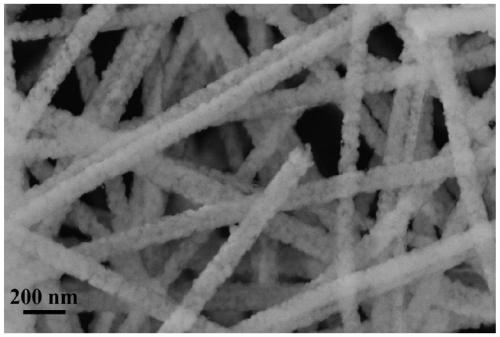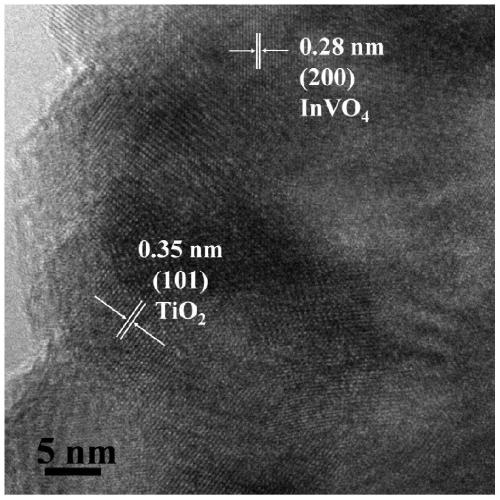A gas sensor based on titanium dioxide/indium vanadate heterostructure nanofibers and its application
A nanofiber and heterostructure technology, which is applied in the field of gas sensing elements, can solve the problems of uneven distribution of heterojunctions, cumbersome processes, and difficult to control sample morphology, and achieve good selectivity.
- Summary
- Abstract
- Description
- Claims
- Application Information
AI Technical Summary
Problems solved by technology
Method used
Image
Examples
Embodiment 1
[0055] (1) 0.68g of tetrabutyl titanate, 1.6g of absolute ethanol, 1.6g of glacial acetic acid and 0.28g of polyvinylpyrrolidone (average molecular weight is 1,300,000) are mixed and stirred to form a solution which is designated as solution A; 0.18 g of vanadium oxide diacetylacetonate, 0.19g of hydrated indium nitrate (In(NO 3 ) 3 ﹒ 4.5H 2 (2), the polyvinylpyrrolidone (average molecular weight is 1300000) of 0.16g and the dimethylacetamide of 2g are mixed and stirred and formed solution is recorded as solution B; Finally the A solution that stirs is mixed with B solution and stirred, obtains TBT / In(NO 3 ) 3 / VO(acac) 2 / PVP electrospinning precursor solution.
[0056] (2) The viscous mixed solution C is spun by electrospinning to obtain nanofibers. The specific parameters of electrospinning are as follows: the inner diameter of the electrospinning needle is 0.4 mm, and the distance between the bottom end of the needle and the metal receiving plate is 15cm, the workin...
Embodiment 2
[0065] (1) The tetrabutyl titanate of 0.34g, the dehydrated alcohol of 0.8g, the glacial acetic acid of 0.84g and the polyvinylpyrrolidone (average molecular weight is 1,300,000) of 0.14g are mixed and stirred to form a solution and be designated as solution A; 0.18g of vanadium oxide diacetylacetonate, 0.19g of hydrated indium nitrate (In(NO 3 ) 3 ﹒ 4.5H 2 (2), the polyvinylpyrrolidone (average molecular weight is 1300000) of 0.16g and the dimethylacetamide of 2g are mixed and stirred and formed solution is recorded as solution B; Finally the A solution that stirs is mixed with B solution and stirred, obtains TBT / In(NO 3 ) 3 / VO(acac) 2 / PVP electrospinning precursor solution.
[0066] (2) The viscous mixed solution C is spun by electrospinning to obtain nanofibers. The specific parameters of electrospinning are as follows: the inner diameter of the electrospinning needle is 0.4 mm, and the distance between the bottom end of the needle and the metal receiving plate is ...
Embodiment 3
[0075] (1) The tetrabutyl titanate of 0.34g, the dehydrated alcohol of 0.8g, the glacial acetic acid of 0.84g and the polyvinylpyrrolidone (average molecular weight is 1,300,000) of 0.18g are mixed and stirred to form a solution and be designated as solution A; 0.27g vanadium diacetylacetonate, 0.38g hydrated indium nitrate (In(NO 3 ) 3 ﹒ 4.5H 2 (2), the polyvinylpyrrolidone (average molecular weight is 1,300,000) of 0.32g and the dimethylacetamide of 4g are mixed and stirred and formed solution is denoted as solution B; Finally the A solution that stirs is mixed and stirred with B solution, obtains TBT / In(NO 3 ) 3 / VO(acac) 2 / PVP electrospinning precursor solution.
[0076] (2) The viscous mixed solution C is spun by electrospinning to obtain nanofibers. The specific parameters of electrospinning are as follows: the inner diameter of the electrospinning needle is 0.4 mm, and the distance between the bottom end of the needle and the metal receiving plate is 15cm, the w...
PUM
| Property | Measurement | Unit |
|---|---|---|
| thickness | aaaaa | aaaaa |
| pore size | aaaaa | aaaaa |
| pore size | aaaaa | aaaaa |
Abstract
Description
Claims
Application Information
 Login to View More
Login to View More - R&D
- Intellectual Property
- Life Sciences
- Materials
- Tech Scout
- Unparalleled Data Quality
- Higher Quality Content
- 60% Fewer Hallucinations
Browse by: Latest US Patents, China's latest patents, Technical Efficacy Thesaurus, Application Domain, Technology Topic, Popular Technical Reports.
© 2025 PatSnap. All rights reserved.Legal|Privacy policy|Modern Slavery Act Transparency Statement|Sitemap|About US| Contact US: help@patsnap.com



